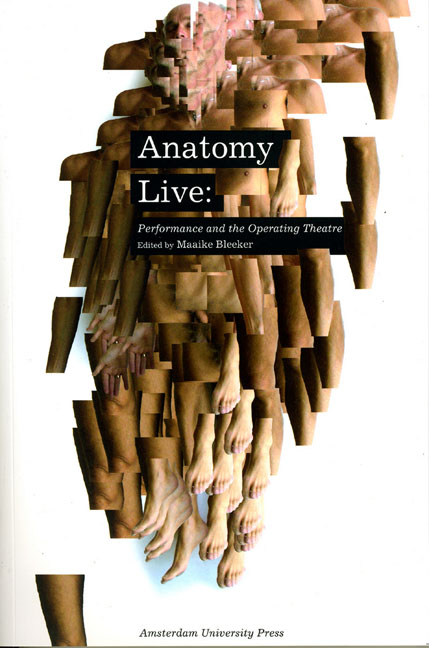Book contents
- Frontmatter
- Contents
- Acknowledgements
- Prologue - Men with Glass Bodies
- Introduction
- Performance Documentation 1: Holoman; Digital Cadaver
- Digital Cadavers and Virtual Dissection
- ‘Who Were You?’: The Visible and the Visceral
- Performance Documentation 2: Excavations: Fresh but Rotten
- The Anatomy Lesson of Professor Moxham
- ‘Be not Faithless But Believing’: Illusion and Doubt in the Anatomy Theatre
- Performance Documentation 3: De Anatomische Les
- Of Dissection and Technologies of Culture in Actor Training Programs – an Example from 1960s West Germany
- Ocular Anatomy, Chiasm, and Theatre Architecture as a Material Phenomenology in Early Modern Europe
- Performance Documentation 4: Camillo – Memo 4.0: The Cabinet of Memories – A Tear Donnor Session
- Martin, Massumi, and the Matrix
- Performance Documentation 5: Sensing Presence no 1: Performing a Hyperlink System
- ‘Where Are You Now?’: Locating the Body in Contemporary Performance
- Performance Documentation 6: Under My Skin
- Anatomies of Live Art
- Performance Documentation 7: Crash
- Restaging the Monstrous
- Delirium of the Flesh: ‘All the Dead Voices’ in the Space of the Now
- Performance Documentation 8: Körper
- Operating Theatres: Body-bits and a Post-apartheid Aesthetics
- Index
‘Where Are You Now?’: Locating the Body in Contemporary Performance
Published online by Cambridge University Press: 10 February 2021
- Frontmatter
- Contents
- Acknowledgements
- Prologue - Men with Glass Bodies
- Introduction
- Performance Documentation 1: Holoman; Digital Cadaver
- Digital Cadavers and Virtual Dissection
- ‘Who Were You?’: The Visible and the Visceral
- Performance Documentation 2: Excavations: Fresh but Rotten
- The Anatomy Lesson of Professor Moxham
- ‘Be not Faithless But Believing’: Illusion and Doubt in the Anatomy Theatre
- Performance Documentation 3: De Anatomische Les
- Of Dissection and Technologies of Culture in Actor Training Programs – an Example from 1960s West Germany
- Ocular Anatomy, Chiasm, and Theatre Architecture as a Material Phenomenology in Early Modern Europe
- Performance Documentation 4: Camillo – Memo 4.0: The Cabinet of Memories – A Tear Donnor Session
- Martin, Massumi, and the Matrix
- Performance Documentation 5: Sensing Presence no 1: Performing a Hyperlink System
- ‘Where Are You Now?’: Locating the Body in Contemporary Performance
- Performance Documentation 6: Under My Skin
- Anatomies of Live Art
- Performance Documentation 7: Crash
- Restaging the Monstrous
- Delirium of the Flesh: ‘All the Dead Voices’ in the Space of the Now
- Performance Documentation 8: Körper
- Operating Theatres: Body-bits and a Post-apartheid Aesthetics
- Index
Summary
The Renaissance anatomy theatre, and the culture of dissection it represents, inaugurated new paradigms of subjectivity and corporeality. It helped to establish the body as a stable and consolidated entity capable of providing a singular perspective onto the world. The inert and mute body of the corpse came to vivify the body as machine, the body that transported a perceiving and thinking subject. As Maaike Bleeker has shown, this regimen of visuality, installed as part of the culture of dissection, began to consolidate a single and seemingly objective perspective from which to view the world (Bleeker, 2002). And, as Jonathan Sawday has observed, the adventure of discovering and charting the interior of the body coincided with and perhaps enabled the exploration of the foreign world (Sawday, 1995, pp. 22-32). Colonization of the body's matt er took place using the same guiding principles as the colonization of foreign peoples and resources.
The invention of the anatomy theatre coincided with a new kinaesthetic awareness of one's positionality in the world. New cartographic technologies, such as Mercator 's implementation of a horizontal and vertical grid to contain and locate the world's land masses, required a way of reading that privileged the single and stationary subject. Just as the body in the anatomy theatre presented itself as a stationary object of study to be investigated by the anatomist, so too, the landscape that emerged with the latest cartographic innovations of the sixteenth and seventeenth centuries off ered up a static territory for survey by a viewer who could see all from a singular, elevated position. Rather than the narrative approach to conveying directions, identified by Michel de Certeau as the ‘tour’, all those who would explore the world now relied upon the ‘map’ (De Certeau, 1984). They learned to place themselves within and upon this grid, an abstract horizontal plane that, as Paul Carter has shown, uprooted all living things from their local ecologies and placed them within the taxonomic rubric that measured diff erence in standardized terms as a product of degree (Carter, 1987).
- Type
- Chapter
- Information
- Anatomy LivePerformance and the Operating Theatre, pp. 169 - 180Publisher: Amsterdam University PressPrint publication year: 2008



